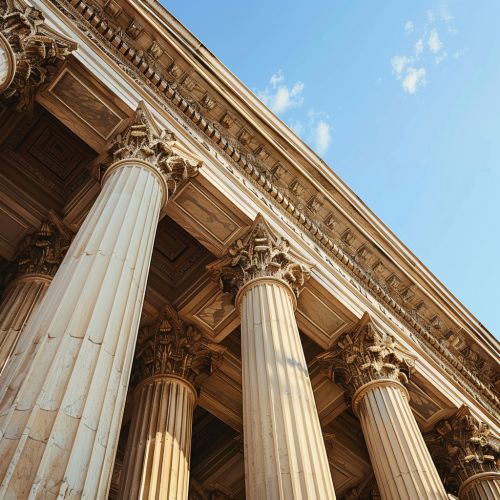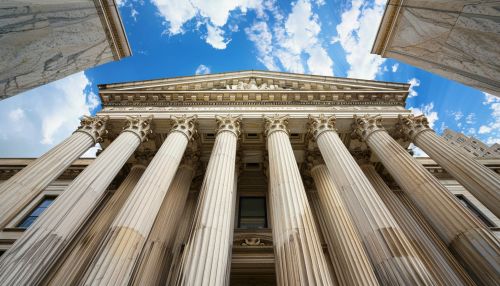United States federal court system: Difference between revisions
(Created page with "== Overview of the United States Federal Court System == The United States federal court system is a complex and multi-tiered structure designed to adjudicate cases involving federal law and constitutional issues. It operates independently of the state court systems and is governed by the principles set forth in the Constitution. The federal judiciary is composed of various courts with distinct functions, jurisdictions, and levels of autho...") |
No edit summary |
||
| Line 9: | Line 9: | ||
=== District Courts === | === District Courts === | ||
[[Image:Detail-92927.jpg|thumb|center|A federal district court building with classical architecture and columns.|class=only_on_mobile]] | |||
[[Image:Detail-92928.jpg|thumb|center|A federal district court building with classical architecture and columns.|class=only_on_desktop]] | |||
The United States district courts are the general trial courts of the federal system. Each state has at least one district court, and larger states have multiple districts. These courts handle a wide range of cases, including civil and criminal matters. District courts are the first level of the federal judiciary where cases are initially filed and tried. They have original jurisdiction over most federal cases, meaning they are the first to hear these cases. | The United States district courts are the general trial courts of the federal system. Each state has at least one district court, and larger states have multiple districts. These courts handle a wide range of cases, including civil and criminal matters. District courts are the first level of the federal judiciary where cases are initially filed and tried. They have original jurisdiction over most federal cases, meaning they are the first to hear these cases. | ||
Latest revision as of 19:58, 21 June 2024
Overview of the United States Federal Court System
The United States federal court system is a complex and multi-tiered structure designed to adjudicate cases involving federal law and constitutional issues. It operates independently of the state court systems and is governed by the principles set forth in the Constitution. The federal judiciary is composed of various courts with distinct functions, jurisdictions, and levels of authority.
Structure of the Federal Court System
The federal court system is divided into three main levels: the district courts, the courts of appeals, and the Supreme Court.
District Courts


The United States district courts are the general trial courts of the federal system. Each state has at least one district court, and larger states have multiple districts. These courts handle a wide range of cases, including civil and criminal matters. District courts are the first level of the federal judiciary where cases are initially filed and tried. They have original jurisdiction over most federal cases, meaning they are the first to hear these cases.
District court judges are appointed by the President and confirmed by the Senate. They serve lifetime appointments, ensuring judicial independence. Magistrate judges assist district judges by handling pretrial matters and other judicial proceedings as assigned.
Courts of Appeals
The United States courts of appeals, also known as circuit courts, are the intermediate appellate courts in the federal system. There are 13 courts of appeals, each covering a specific geographic area known as a circuit. These courts review decisions made by the district courts within their respective circuits.
The primary function of the courts of appeals is to determine whether the law was applied correctly in the trial court. They do not conduct new trials but rather review the record of the lower court proceedings. Panels of three judges typically hear cases, although en banc sessions, where all the judges of a circuit hear a case, can occur in significant matters.
Judges on the courts of appeals are also appointed by the President and confirmed by the Senate, serving lifetime terms.
Supreme Court
The Supreme Court of the United States is the highest court in the federal judiciary. It has ultimate appellate jurisdiction over all federal and state court cases involving issues of federal law. The Supreme Court also has original jurisdiction in a limited range of cases, such as disputes between states.
The Court is composed of nine justices, including one Chief Justice and eight Associate Justices. Justices are nominated by the President and confirmed by the Senate, serving lifetime appointments. The Supreme Court's decisions are final and binding on all lower courts.
Jurisdiction and Powers
The jurisdiction of the federal courts is defined by the Constitution and federal statutes. Federal courts have jurisdiction over cases involving federal laws, treaties, and the Constitution. They also hear cases where the United States is a party, disputes between states, and cases involving citizens of different states (diversity jurisdiction).
Federal courts have the power of judicial review, allowing them to invalidate laws and executive actions that are found to be unconstitutional. This power was established in the landmark case of Marbury v. Madison.
Specialized Courts
In addition to the general jurisdiction courts, the federal judiciary includes several specialized courts designed to handle specific types of cases.
United States Bankruptcy Courts
Bankruptcy courts are units of the district courts and handle bankruptcy cases. These courts have exclusive jurisdiction over bankruptcy matters, ensuring uniform application of bankruptcy laws across the country.
United States Tax Court
The United States Tax Court is an independent judicial body that adjudicates disputes between taxpayers and the Internal Revenue Service (IRS). It provides a forum for taxpayers to challenge IRS determinations before paying the disputed amount.
United States Court of Federal Claims
The Court of Federal Claims hears monetary claims against the United States government. It handles a variety of cases, including government contracts, takings claims, and tax refund suits.
United States Court of International Trade
The Court of International Trade has nationwide jurisdiction over cases involving international trade and customs laws. It ensures the uniform application of trade laws and resolves disputes arising from trade policies.
Administrative Structure
The federal court system is overseen by the Judicial Conference of the United States, which sets policy and administrative guidelines. The Administrative Office of the United States Courts provides support and services to the federal judiciary, including budget management, human resources, and technology services.
Federal Judicial Center
The Federal Judicial Center is the research and education agency for the federal judiciary. It conducts research on judicial administration and provides training and education programs for federal judges and court personnel.
Conclusion
The United States federal court system is a vital component of the nation's governance, ensuring the fair and impartial administration of justice. Its multi-tiered structure, specialized courts, and administrative bodies work together to uphold the rule of law and protect individual rights.
